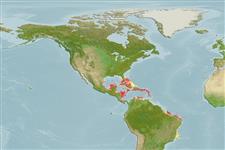Common names from other countries
Environment: milieu / climate zone / depth range / distribution range
Ecologia
Associadas(os) a recifes; estuarina; intervalo de profundidade 9 - 12 m (Ref. 108813). Tropical
Western Central Atlantic.
Length at first maturity / Tamanho / Peso / Idade
Maturity: Lm ? range ? - ? cm Max length : 50.0 cm TL macho/indeterminado; (Ref. 415)
Laterally fused tubes running on branches (Ref. 81728): up to 50 cm long, 10 - 20 cm in diameter. Light to purplish brown externally, yellow to tan internally. The surface is smooth, with meandering groves occasionally. Oscules on the inner walls of the tubes few millimeters in diameter (Ref. 415).
Coral reefs, usually below 10 m in depth (Ref. 415). Also occurs in mangrove ponds (Ref. 86789).
Life cycle and mating behavior
Maturidade | Reprodução | Desova | Ovos | Fecundidade | Larvas
Members of the class Demospongiae are hermaphroditic. Life cycle: The zygote develops into parenchymella larva (free-swimming) before settling down on a substrate where it grows into a young sponge.
Collin, R., M.C. Díaz, J. Norenburg, R.M. Rocha, J.A. Sánchez, M. Schulze, A. Schwartz and A. Valdés. 2005. (Ref. 415)
Status na Lista Vermelha da IUCN (Ref. 130435)
Status no CITES (Ref. 108899)
Not Evaluated
Not Evaluated
Perigo para os humanos
Harmless
Uso pelos humanos
| FishSource |
Ferramentas
Mais informação
Idade/TamanhoCrescimentoComprimento-pesoComprimento-comprimentoMorfologiaLarvasAbundância
Fontes da internet
Estimates based on models
Preferred temperature
(Ref.
115969): 26.1 - 28.1, mean 27 (based on 188 cells).
Vulnerabilidade
Moderate vulnerability (40 of 100).
Categoria de preço
Unknown.
